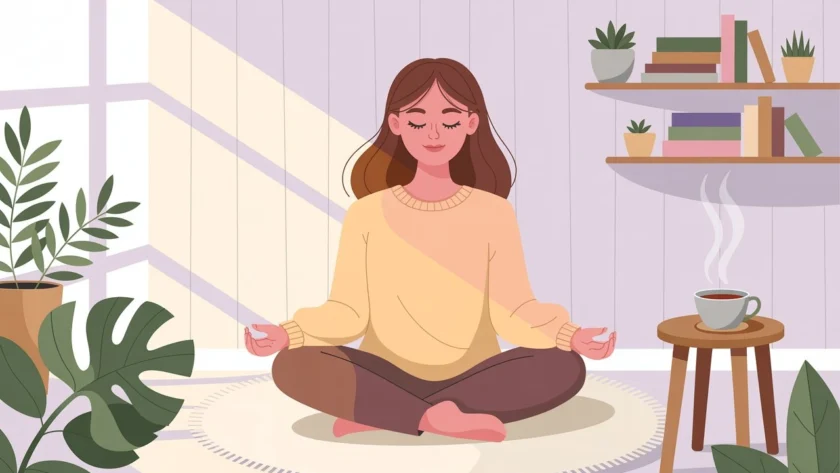When your mind feels like a hamster wheel that won’t stop spinning, the last thing you want to hear is someone telling you to “just relax and take care of yourself.” Trust me, as someone who spent years white-knuckling through anxiety attacks while everyone around me suggested bubble baths and herbal tea, those well-meaning suggestions can feel pretty hollow.
But here’s what nobody told me back then: self-care for General Anxiety Disorder isn’t about pampering yourself into wellness. It’s about building a practical, daily toolkit that actually works when your nervous system goes into overdrive. It’s about creating small pockets of peace that help you manage the very real symptoms of GAD, from that persistent worry that follows you like a shadow to the physical tension that makes your shoulders feel like they’re made of concrete.
After walking through my own decade-long journey with anxiety and now helping others do the same, what truly matters isn’t the Pinterest-perfect version of self-care. What matters is discovering which practices genuinely calm your nervous system, reduce your stress response, and help you navigate daily life with more emotional stability. And yes, faith plays a beautiful role in this healing process too.
Understanding General Anxiety Disorder Beyond the Worry
Before we dive into self-care strategies, let’s get honest about what we’re actually dealing with. General Anxiety Disorder isn’t just being a “worrier” or someone who gets nervous before big events. GAD involves persistent, excessive worry about various aspects of life that interferes with your daily functioning for at least six months.
The symptoms go far beyond mental worry. Your body carries this anxiety too—muscle tension, fatigue, difficulty concentrating, irritability, and sleep disturbances are all part of the package. When people suggest self-care, they’re not minimizing these very real symptoms. They’re recognizing that you need practical tools to manage both the emotional and physical aspects of anxiety.
What changed everything for me was understanding that self-care isn’t selfish—it’s essential maintenance for a nervous system that’s working overtime. Think of it like this: if your car’s engine was constantly running hot, you wouldn’t ignore it and hope for the best. You’d take steps to cool it down and prevent long-term damage.
The Biblical Foundation for Self-Care
Sometimes in Christian circles, there’s this underlying belief that focusing on self-care is somehow selfish or shows a lack of faith. But here’s what Scripture actually teaches us about caring for ourselves: “Haven’t you yet learned that your body is the home of the Holy Spirit God gave you, and that he lives within you?” (1 Corinthians 6:19, TLB).
Jesus himself modeled the importance of stepping away to rest and recharge. He withdrew to quiet places to pray (Luke 5:16), took time for meals with friends, and even slept during storms. These weren’t signs of weakness—they were necessary practices for sustained ministry and emotional well-being.
When we’re managing anxiety, self-care becomes a way of stewarding the life God has given us. It’s not about earning God’s love through perfect wellness routines, but about creating space for His peace to work in our hearts and minds.
Physical Self-Care Practices That Actually Work for GAD
Let’s talk about self-care practices that genuinely help with anxiety symptoms, not just the Instagram-worthy ones that look good in photos.
Movement That Calms Rather Than Intensifies
Exercise is often touted as the cure-all for anxiety, but here’s the thing nobody mentions: high-intensity workouts can actually trigger anxiety symptoms in some people with GAD. The elevated heart rate and adrenaline can mimic panic responses.
What works better for many of us is gentle, rhythmic movement. Walking has been my saving grace—there’s something about the repetitive motion that helps quiet my racing thoughts. Swimming offers that same rhythmic quality, plus the added benefit of controlled breathing. Yoga combines gentle movement with mindfulness, creating a double benefit for anxious minds.
The key isn’t to exhaust yourself into calmness. It’s to move your body in ways that release physical tension while signaling safety to your nervous system.
Sleep Hygiene That Goes Deeper Than Screen Time
Everyone talks about avoiding screens before bed, but anxiety-related insomnia requires a more comprehensive approach. Your bedtime routine needs to start hours before you actually lie down.
What’s helped me tremendously is creating what call an “anxiety wind-down protocol.” About two hours before bed, dim the lights throughout your house. This signals to your brain that day is transitioning to night. An hour before bed, do something that requires gentle focus—puzzles, adult coloring books, or reading something light and engaging.
Here’s the part that might surprise you: pray or meditate right before getting into bed, not after you’re already lying there with your thoughts racing. When you’re horizontal with nothing to distract you, anxious thoughts tend to multiply. Instead, spend ten minutes sitting on the edge of your bed, talking to God about your worries, or practicing a simple breathing prayer.
Nutrition for Nervous System Support
The connection between what we eat and how we feel isn’t just about avoiding caffeine (though that definitely matters for anxiety). It’s about nourishing a nervous system that’s already working overtime.
Magnesium deficiency is incredibly common and can exacerbate anxiety symptoms. Foods rich in magnesium—like dark leafy greens, nuts, and seeds—can provide gentle support for muscle relaxation and nervous system function. B-vitamins, found in whole grains and lean proteins, support neurotransmitter production.
But here’s the bigger picture: erratic blood sugar levels can trigger anxiety-like symptoms. Eating regular, balanced meals helps keep your system stable, which makes it easier to manage worry and stress.
Emotional Self-Care: Building Your Resilience Reserves
Emotional self-care for GAD isn’t about positive thinking your way out of anxiety. It’s about developing practical skills for managing difficult emotions and building resilience for the challenges ahead.
The Practice of Naming and Claiming
One of the most powerful emotional self-care practices is learning to name what you’re experiencing without judgment. Instead of “I’m being ridiculous,” try “I’m noticing anxiety right now.” This simple shift moves you from self-criticism to self-awareness.
In my own journey, adding a spiritual element to this practice has been transformative. After naming the emotion, claim God’s truth over the situation: “I’m noticing anxiety about tomorrow’s meeting, and remember that God goes before me into every situation.”
Boundary Setting as Sacred Work
People with GAD often struggle with boundaries because we’re constantly worried about disappointing others or making situations worse. But healthy boundaries aren’t mean or selfish—they’re necessary for managing your mental and emotional energy.
This might mean saying no to social commitments when you’re already overwhelmed, or asking for specific support from family members. It could mean limiting news consumption or setting phone-free hours during your day.
Scripture supports this approach: “Above all else, guard your heart, for everything you do flows from it” (Proverbs 4:23). Protecting your emotional well-being isn’t selfish—it’s biblical stewardship.
Building a Feelings Vocabulary
Many of us with anxiety have learned to label everything as either “fine” or “anxious.” But emotions are much more nuanced than that, and being able to identify specific feelings helps you respond more appropriately.
Are you feeling overwhelmed, worried, frustrated, disappointed, or scared? Each of these emotions might require different self-care responses. Overwhelm might need a simplified schedule, while loneliness might need connection with a trusted friend.
Mental and Spiritual Self-Care Strategies
The intersection of mental and spiritual self-care is where real transformation happens for many people managing GAD. This isn’t about replacing professional treatment with spiritual practices, but about creating a comprehensive approach that addresses both symptoms and soul.
Contemplative Practices for Anxious Minds
Traditional meditation can feel impossible when your thoughts are racing, but there are contemplative practices specifically designed for anxious minds. Lectio Divina, an ancient Christian practice of slowly reading and reflecting on Scripture, gives your mind something specific to focus on while connecting you with God’s peace.
Another practice that’s been invaluable in my own healing is what call “worry prayers.” Instead of trying not to worry, take your specific concerns directly to God in prayer. “Lord, I’m anxious about my daughter’s college decision. Help her find the path you have for her, and help me trust your timing.”
Creating Sacred Rhythms
Self-care isn’t just about crisis management—it’s about creating sustainable rhythms that support your overall well-being. This might include a weekly Sabbath rest, daily morning quiet time, or monthly spiritual direction sessions.
The beauty of sacred rhythms is that they provide structure without being rigid. When anxiety makes everything feel chaotic, having gentle rhythms to return to provides stability and predictability.
Journaling as Emotional Processing
Writing can be incredibly therapeutic for GAD, but not the way most people think. Instead of trying to journal your way to positivity, use writing as a way to process and release anxious thoughts.
Try the “brain dump” method: set a timer for ten minutes and write everything that’s worrying you without stopping to edit or organize. Then, go back and circle the things you actually have some control over. This helps separate actionable concerns from the endless “what-if” spirals that fuel anxiety.
The Role of Community in Self-Care
One of the most overlooked aspects of self-care for anxiety is community support. GAD can be incredibly isolating—you worry about being a burden, about others not understanding, about being judged for your struggles.
But healing happens in relationship, not just in solitude. This doesn’t mean you need to share your deepest struggles with everyone, but it does mean cultivating a few trusted relationships where you can be honest about your challenges.
Consider joining a support group, working with a Christian counselor, or simply being more intentional about maintaining friendships that feel safe and supportive. Sometimes self-care looks like showing up to small group even when you don’t feel like it, or texting a friend when you’re having a hard day.
Creating Your Personal Self-Care Plan
The goal isn’t to implement every strategy mentioned here—that would just create more anxiety! Instead, choose one or two practices from each category that resonate with you and commit to trying them for two weeks.
Start small and be consistent rather than trying to overhaul your entire life overnight. Maybe it’s a ten-minute evening walk three times a week, plus a simple breathing prayer before bed. Or perhaps it’s meal planning on Sundays and joining a weekly Bible study.
Pay attention to what actually helps versus what you think should help. Your self-care plan should feel sustainable and genuinely supportive, not like another item on your to-do list.
When Self-Care Isn’t Enough
Here’s something important that often gets left out of self-care conversations: sometimes self-care alone isn’t sufficient for managing GAD. If your anxiety is significantly interfering with work, relationships, or daily functioning, professional help isn’t a sign of failed self-care—it’s another essential tool in your toolkit.
Therapy, particularly cognitive-behavioral therapy (CBT) and acceptance and commitment therapy (ACT), can provide specific skills for managing anxiety symptoms. Medication might be helpful for some people in managing the physical symptoms of anxiety while working on emotional and spiritual healing.
Self-care works best as part of a comprehensive approach that might include professional support, community connection, spiritual practices, and lifestyle changes.
Finding Hope in the Journey
Managing General Anxiety Disorder isn’t about achieving a worry-free life—it’s about learning to live fully and faithfully even with anxiety as an occasional companion. Self-care practices don’t eliminate anxiety, but they do provide tools for responding to it with greater wisdom and less fear.
The most important thing to remember is that healing isn’t linear, and self-care isn’t about perfection. Some days you’ll nail your morning routine and feel centered and peaceful. Other days you’ll barely manage the basics, and that’s okay too.
God’s love for you isn’t dependent on how well you manage your anxiety or how consistently you practice self-care. His love is constant, whether you’re thriving or struggling. Self-care is simply one way we participate in the healing and wholeness He desires for us.
As you begin implementing these self-care practices, remember that small, consistent steps create lasting change. You don’t have to have everything figured out today. You just need to take the next right step, trusting that God is walking alongside you in this journey toward greater peace and emotional well-being.
Your anxiety doesn’t define you, and your struggle with GAD doesn’t disqualify you from living a meaningful, purposeful life. With the right combination of practical self-care, spiritual practices, professional support when needed, and community connection, you can learn to manage your anxiety symptoms while continuing to grow in faith and flourish in life.



